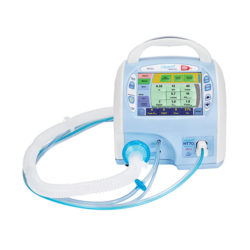The New York Times has a report on the failure of a very promising government contract to stock up the national ventilator supply. The deal was sent out for bids in 2008 and awarded to a small company called Newport shortly thereafter. Everything was going great — until it wasn’t.
But it seems to me this story — the product of three reporters on the New York Times (@nkulish @sarahkliff & @jbsgreenberg) — is short on a rather critical fact. See for yourself:
The contract called for Newport to receive $6.1 million upfront, with the expectation that the government would pay millions more as it bought thousands of machines to fortify the stockpile.
Project Aura was Newport’s first job for the federal government. Things moved quickly and smoothly, employees and federal officials said in interviews.
Every three months, officials with the biomedical research agency would visit Newport’s headquarters. Mr. Crawford submitted monthly reports detailing the company’s spending and progress.
The federal officials “would check everything,” he said. “If we said we were buying equipment, they would want to know what it was used for. There were scheduled visits, scheduled requirements and deliverables each month.”
In 2011, Newport shipped three working prototypes from the company’s California plant to Washington for federal officials to review.
Dr. Frieden, who ran the C.D.C. at the time, got a demonstration in a small conference room attached to his office. “I got all excited,” he said. “It was a multiyear effort that had resulted in something that was going to be really useful.”
In April 2012, a senior Health and Human Services official testified before Congress that the program was “on schedule to file for market approval in September 2013.” After that, the machines would go into production.
Then everything changed.
The medical device industry was undergoing rapid consolidation, with one company after another merging with or acquiring other makers. Manufacturers wanted to pitch themselves as one-stop shops for hospitals, which were getting bigger, and that meant offering a broader suite of products. In May 2012, Covidien, a large medical device manufacturer, agreed to buy Newport for just over $100 million.
Covidien — a publicly traded company with sales of $12 billion that year — already sold traditional ventilators, but that was only a small part of its multifaceted businesses. In 2012 alone, Covidien bought five other medical device companies, in addition to Newport.
Newport executives and government officials working on the ventilator contract said they immediately noticed a change when Covidien took over. Developing inexpensive portable ventilators no longer seemed like a top priority.
Newport applied in June 2012 for clearance from the Food and Drug Administration to market the device, but two former federal officials said Covidien had demanded additional funding and a higher sales price for the ventilators. The government gave the company an additional $1.4 million, a drop in the bucket for a company Covidien’s size.
Government officials and executives at rival ventilator companies said they suspected that Covidien had acquired Newport to prevent it from building a cheaper product that would undermine Covidien’s profits from its existing ventilator business.
Some Newport executives who worked on the project were reassigned to other roles. Others decided to leave the company.
“Up until the time the company sold, I was really happy and excited about the project,” said Hong-Lin Du, Newport’s president at the time of its sale. “Then I was assigned to a different job.”
In 2014, with no ventilators having been delivered to the government, Covidien executives told officials at the biomedical research agency that they wanted to get out of the contract, according to three former federal officials. The executives complained that it was not sufficiently profitable for the company.
The government agreed to cancel the contract.

Newport™ HT70 Plus Ventilator sold by Medtronic
But all we get as explanation is this: “The world was focused at the time on the Ebola outbreak in West Africa.” The government was distracted? No one was looking? What does this mean?
Is it too much to hope for a followup story?
Meanwhile, Covidien, which bought Newport, was in turn bought by Medtronic. Medctronic’s web page advertises a Newport™ HT70 Plus Ventilator” which it touts as “Quick to set up, easy to use and durable to withstand rough treatment.” I have no idea how this relates to Project Aura, but I’d sort of like to know that too…

…like many “news” stories….forgot Who, What, Where, When, Why. and waht about the money…as in was it given back….Who would write a contract like that….was it bonded etc. Wild how we are lulled into thinking the water in this post is not getting hotter.